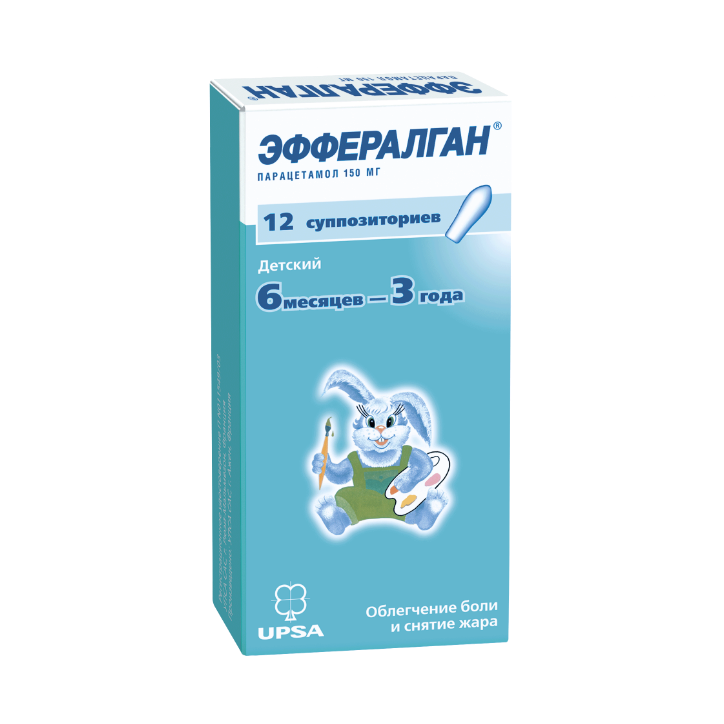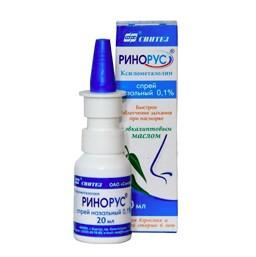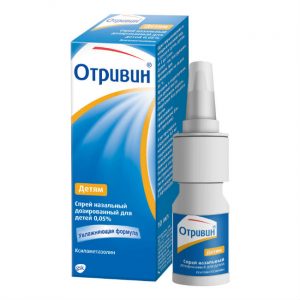Description
Latin name
Efferalgan
Release form
Suppositories recta nye
packaging 12 pcs
Pharmacological action of
Efferalgan contains paracetamol, which blocks COX-1 and -2 mainly in the central nervous system, acting on the centers of pain and thermoregulation. In inflamed tissues, cellular peroxidases neutralize the effect of paracetamol on COX, which explains the almost complete absence of anti-inflammatory effect.
The absence of a blocking effect on the synthesis of PG in peripheral tissues leads to the absence of a negative effect on the water-salt metabolism (delay of Na + and water) and the gastrointestinal mucosa.
Suppositories have analgesic, antipyretic and mild anti-inflammatory effects.
Indications
in children as an antipyretic for acute respiratory infections, flu, childhood infections, post-vaccinations and other infectious and inflammatory diseases accompanied by fever
as an anesthetic for mild to moderate pain, including . headache and toothache, muscle pain, neuralgia, pain from injuries and burns.
Contraindications
severe liver dysfunction or decompensated active liver disease
severe renal dysfunction
blood disease
enzyme deficiency glucose-6-phosphate dehydrogenase
early chest infection (up to 3 months of age) associated with the route of administration)
hypersensitivity to paracetamol, propacetamol hydrochloride (paracetamol prodrug) or other components of the drug.
The drug should be used with caution in case of impaired liver function, Gilbert syndrome, dehydration, hypovolemia, as well as anorexia, bulimia or cachexia (insufficient supply of glutathione in the liver).
Before taking the drug, consult your doctor.
In case of impaired renal function, the time interval between doses of the drug should be at least 8 hours with creatinine clearance (CC) of less than 10 ml / min, at least 6 hours with CC more than or equal to 10 ml / min.
The drug should not be used if the child has diarrhea.
Use during pregnancy and lactation
The drug should be used with caution during pregnancy and during breastfeeding.
Composition
1 suppository contains:
Active mg:
Excipients:
semi-synthetic glycerides (solid fat) – 850 mg.
Dosage and administration
Rectally. After releasing the suppository from the package, enter into the anus of the child (preferably after a cleansing enema or spontaneous bowel movement).
The average single dose of Efferalgan depends on the body weight of the child and is 10-15 mg / kg 3-4 times a day. The maximum daily dose should not exceed 60 mg / kg.
For children from 3 to 5 months (with a body weight of 6 8 kg) – 1 suppository (80 mg) 6 months – 3 years (with a body weight of 10 14 kg) – 1 candle (150 mg) 5 10 years (with a body weight of 20-30 kg) – 1 suppository (300 mg) 3 4 times a day after 4 6 hours. Do not use more than 4 suppositories per day.
Duration of treatment – 3 days as an antipyretic and up to 5 days as a painkiller.
When using the drug for more than a week, monitoring of the functional state of the liver and the picture of peripheral blood is necessary.
Side effects
In rare cases, nausea, vomiting, allergic reactions (skin rash, itching, urticaria, Quincke’s edema), irritation of the rectal mucosa, tenesmus extremely rare – anemia, thrombocytopenia, methemoglobinemia, leukemia.
With prolonged use in large doses, hepatotoxic and nephrotoxic effects are possible.
Drug Interaction
Phenytoin reduces the effectiveness of paracetamol and increases the risk of hepatotoxicity. Patients taking phenytoin should avoid frequent use of paracetamol, especially at high doses. Patients should be monitored for hepatotoxicity.
Probenecid reduces the clearance of paracetamol by almost 2 times, inhibiting the process of conjugation with glucuronic acid. When administered concurrently, consideration should be given to reducing the dose of paracetamol.
Caution should be exercised when co-administering paracetamol and inducers of microsomal liver enzymes (eg, ethanol, barbiturates, isoniazid, rifampicin, carbamazepine, anticoagulants, zidovudine, amoxicillin + clavulanic acid, phenylbutazone, tricyclic antidepressants).
Prolonged use of barbiturates reduces the effectiveness of paracetamol.
Salicylamide increases T1 / 2 of paracetamol.
The International Normalized Relationship (INR) should be monitored during and after concurrent use of paracetamol (especially at high doses and / or for prolonged periods) and coumarins (eg warfarin), as well. Paracetamol, when administered at a dose of 4 g for at least 4 days, can enhance the effect of indirect anticoagulants.
Inform the attending physician of the use of the drug Efferalgan ® when performing tests for uric acid and blood glucose.
overdose
Symptoms:
signs of acute paracetamol poisoning are nausea, vomiting, anorexia, epigastric pain, sweating, paleness of the skin, which appear in the first 24 h after administration. Ingestion of paracetamol at a dose of 140 mg / kg body weight in children causes the destruction of liver cells, leading to complete and irreversible hepatonecrosis, liver failure, metabolic acidosis, encephalopathy, which, in turn, can lead to coma and death.
Increased levels of liver transaminases (ALT, ACT), lactate dehydrogenase, and bilirubin may be observed 12-48 h after administration while reducing prothrombin levels. The clinical picture of liver damage is usually detected after 1 or 2 days and peaks in 3-4 days.
Treatment:
If symptoms of poisoning appear, discontinuation of the drug and immediate hospitalization are recommended. Blood samples should be taken for the initial determination of paracetamol plasma levels. The gastric lavage is performed in case of oral administration of the drug, intersorbent intake (activated charcoal, lignin hydrolysis), administration of acetylcysteine antidote (in / or orally) within up to 8 hours after ingestion. Acetylcysteine can be effective even after 16 hours after overdose. They also conduct symptomatic treatment.
Liver tests should be performed at the beginning of treatment and then every 24 hours. In most cases, the activity of hepatic transaminases is normalized within 1-2 weeks. In very severe cases, a liver transplant may be required.
Hepatotoxic and nephrotoxic effects are possible with prolonged use at high doses.
Storage conditions
At a temperature not exceeding 30 ° C.
Shelf suitability
3 Year
Deystvuyuschee substances
Paracetamol
Pharmacy holiday conditions
Over-the-counter
Dosage form
dosage form
rectal suppositories
Uppsala SAS, France




